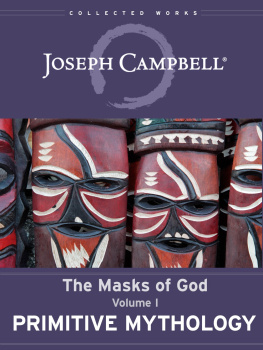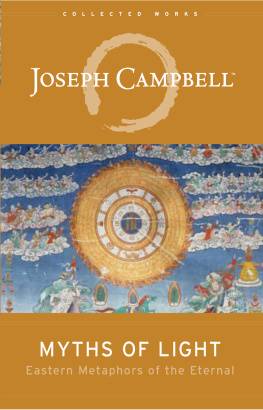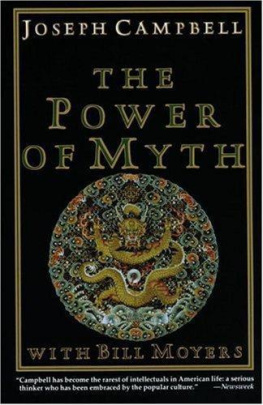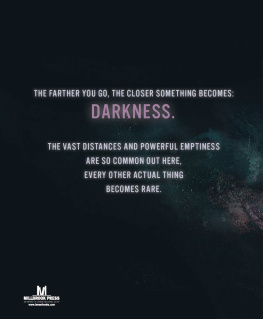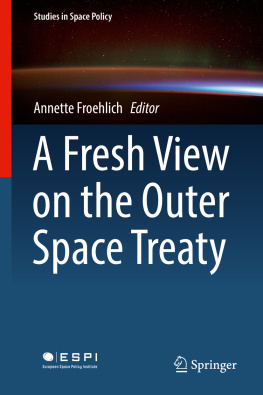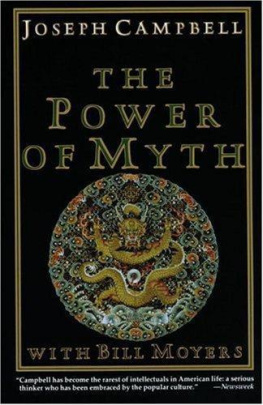Joseph Campbell - The Inner Reaches of Outer Space: Metaphor as Myth and as Religion
Here you can read online Joseph Campbell - The Inner Reaches of Outer Space: Metaphor as Myth and as Religion full text of the book (entire story) in english for free. Download pdf and epub, get meaning, cover and reviews about this ebook. year: 2018, publisher: New World Library, genre: Religion. Description of the work, (preface) as well as reviews are available. Best literature library LitArk.com created for fans of good reading and offers a wide selection of genres:
Romance novel
Science fiction
Adventure
Detective
Science
History
Home and family
Prose
Art
Politics
Computer
Non-fiction
Religion
Business
Children
Humor
Choose a favorite category and find really read worthwhile books. Enjoy immersion in the world of imagination, feel the emotions of the characters or learn something new for yourself, make an fascinating discovery.
- Book:The Inner Reaches of Outer Space: Metaphor as Myth and as Religion
- Author:
- Publisher:New World Library
- Genre:
- Year:2018
- Rating:4 / 5
- Favourites:Add to favourites
- Your mark:
- 80
- 1
- 2
- 3
- 4
- 5
The Inner Reaches of Outer Space: Metaphor as Myth and as Religion: summary, description and annotation
We offer to read an annotation, description, summary or preface (depends on what the author of the book "The Inner Reaches of Outer Space: Metaphor as Myth and as Religion" wrote himself). If you haven't found the necessary information about the book — write in the comments, we will try to find it.
Joseph Campbell: author's other books
Who wrote The Inner Reaches of Outer Space: Metaphor as Myth and as Religion? Find out the surname, the name of the author of the book and a list of all author's works by series.
The Inner Reaches of Outer Space: Metaphor as Myth and as Religion — read online for free the complete book (whole text) full work
Below is the text of the book, divided by pages. System saving the place of the last page read, allows you to conveniently read the book "The Inner Reaches of Outer Space: Metaphor as Myth and as Religion" online for free, without having to search again every time where you left off. Put a bookmark, and you can go to the page where you finished reading at any time.
Font size:
Interval:
Bookmark:
For
Barbara, Jean, and Lynne


FOREWORD
The chapters of this volume have been developed from lectures delivered in San Francisco, 19811984, to themes proposed by Barbara McClintock, Director of Public Programs at the C. G. Jung Institute in that city, and by Lynne Kaufman, Program Director, International Studies, at the University of California, Berkeley. The Inner Reaches of Outer Space was the title and topic of a symposium organized by Barbara McClintock in 1983, where, before an immense audience brought together in the great hall of The Palace of Fine Arts, I shared the platform with the astronaut Rusty Schweickart. Metaphor As Myth and As Religion was the title of my address delivered in 1984, also in that great hall, at the festival instituted by Lynne Kaufman in celebration of my eightieth birthday. The poet Robert Bly, archaeologist Marija Gimbutas, tai chi master Al Chungliang Huang, philosopher Sam Keen, psychologist Stanley Keleman, and anthropologist Barbara Meyerhoff shared the platform on that spectacular occasion, which terminated with a descent from the high ceiling of a galaxy of balloons. To my wife, Jean Erdman, dancer and choreographer, I owe the whole theme and argument of my lecture The Way of Art, composed in 1981 for Barbara McClintocks symposium, A Call to Beauty, conducted by James Hillman; while my talk on Myth and the Body was introductory to an all-day seminar on mythology as a function of biology, held in 1982 at the C. G. Jung Institute.
My desire and great pleasure in the preparation of this little volume has been as rendering a return gift to the Graces for the transforming insights of these recent years, which, with the cooperation of their wonderfully willing San Francisco audiences, we have been testing out in a broadly shared spiritual adventure.
Joseph Campbell
Reviewing with unprejudiced eye the religious traditions of mankind, one becomes very soon aware of certain mythic motifs that are common to all, though differently understood and developed in the differing traditions: ideas, for example, of a life beyond death, or of malevolent and protective spirits. Adolf Bastian (18261905), a medical man, world traveler, and leading ethnologist of the nineteenth century, for whom the chair in anthropology at the University of Berlin was established, termed these recurrent themes and features elementary ideas, Elementargedanken, designating as ethnic or folk ideas, Vlkergedanken, the differing manners of their representation, interpretation, and application in the arts and customs, mythologies and theologies, of the peoples of this single planet.
Such a recognition of two aspects, a universal and a local, in the constitution of religions everywhere clarifies at one stroke those controversies touching eternal and temporal values, truth and falsehood, which forever engage theologians; besides setting apart, as of two distinct yet related sciences, studies on the one hand of the differing ethnic or folk ideas, which are the concern properly of historians and ethnologists, and on the other hand, of the Elementargedanken, which pertain to psychology. A number of leading psychologists of the past century addressed themselves to the analysis of these universals, of whom Carl G. Jung (18751961), it seems to me, was the most insightful and illuminating. The same mythic motifs that Bastian had termed elementary ideas, Jung called archetypes of the collective unconscious, transferring emphasis, thereby, from the mental sphere of rational ideation to the obscure subliminal abysm out of which dreams arise.
For myths and dreams, in this view, are motivated from a single psychophysiological sourcenamely, the human imagination moved by the conflicting urgencies of the organs (including the brain) of the human body, of which the anatomy has remained pretty much the same since c. 40,000 b.c. Accordingly, as the imagery of a dream is metaphorical of the psychology of its dreamer, that of a mythology is metaphorical of the psychological posture of the people to whom it pertains. The sociological structure coordinate to such a posture was termed by the Africanist Leo Frobenius (18731938) a cultural monad. Every feature of such a social organism is, in his sense, expressive and therefore symbolic of the informing psychological posture. In The Decline of the West, Oswald Spengler (18801936) identified eight colossal monads of great majesty, with a ninth now in formation, as having shaped and dominated world history since the rise, in the fourth millennium b.c. , of the first literate high cultures (1) the Sumero-Babylonian, (2) the Egyptian, (3) the Greco-Roman (Apollonian), (4) the Vedic-Aryan, of India, (5) the Chinese, (6) the Maya-Aztec-Incan, (7) the Magian (Persian-Arabian, Judeo-Christian-Islamic), (8) the Faustian (Gothic-Christian to modern European-American), and now, beneath the imposed alien crust of a Marxian cultural pseudomor-phosis, (9) the germinating Russian-Christian.
Long antecedent, however, to the world-historical appearances, flowerings, and inevitable declines of these monumental monads, an all but timeless period is recognized of nonliterate, aboriginal societiessome nomadic hunters, others settled horticulturalists; some of no more than a half dozen related families, others of tens of thousands. And each had its mythologysome, pitifully fragmentary, but others, marvelously rich and magnificently composed. These mythologies were all conditioned, of course, by local geography and social necessities. Their images were derived from the local landscapes, flora and fauna, from recollections of personages and events, shared visionary experiences, and so forth. Narrative themes and other mythic features, furthermore, have passed from one domain to another. However, the definition of the monad is not a function of the number and character of such influences and details, but of the psychological stance in relation to their universe of the people, whether great or small, of whom the monad is the cohering life. The study of any mythology from the point of view of an ethnologist or historian, therefore, is of the relevance of its metaphors to a disclosure of the structure and force of the nucleating monad by which every feature of the culture is invested with its spiritual sense. Out of this emerge the forms of its art, its tools, and its weapons, ritual forms, musical instruments, social regulations, and ways of relating in war and in peace to its neighbors.
In terms of Bastians vocabulary, these monads are local organizations of the number of ethnic or folk ideas of the represented cultures, constellating variously in relation to current needs and interests the primal energies and urges of the common human species: bioenergies that are of the essence of life itself, and which, when unbridled, become terrific, horrifying, and destructive.
The first, most elementary and horrifying of all, is the innocent voraciousness of life, which feeds on lives and provides the first interest of the infant feeding on its mother. The peace of sleep shatters in nightmare into apparitions of the cannibal ogress, cannibal giant, or approaching crocodile, which are features, also, of the fairy tale. In Dionysiac orgies the culminating frenzies issue still, in some parts of the world, in the merciless group-cannibalizing of living bulls. The most telling mythological image of this grim first premise of life is to be seen in the Hindu figure of the world-mother herself as Kl, Black Time, licking up with her extended, long, red tongue the lives of all the living of this world of her creation. For, as noticed in a paper on ritual killing by Adolf E. Jensen, the late director of the Frobenius Institute in Frankfurt-am-Main, It is the common mark of all animal life that it can maintain itself only by destroying life; citing to this point an Abyssinian song in celebration of the joys of life: He who has not yet killed, shall kill. She who has not yet given birth shall bear.
Next pageFont size:
Interval:
Bookmark:
Similar books «The Inner Reaches of Outer Space: Metaphor as Myth and as Religion»
Look at similar books to The Inner Reaches of Outer Space: Metaphor as Myth and as Religion. We have selected literature similar in name and meaning in the hope of providing readers with more options to find new, interesting, not yet read works.
Discussion, reviews of the book The Inner Reaches of Outer Space: Metaphor as Myth and as Religion and just readers' own opinions. Leave your comments, write what you think about the work, its meaning or the main characters. Specify what exactly you liked and what you didn't like, and why you think so.





